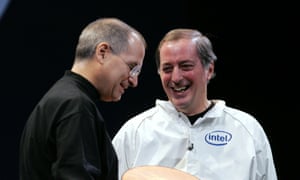Intel shares fall 6% after Apple said to be planning to design chips for computers in-house
Apple is reportedly planning to drop Intel chips from its Mac computers as early as 2020, replacing them with processors designed in-house in the same way the company manufactures iPhones and iPads.
The plan, reported by Bloomberg, has been rumoured for several years, as Applehas taken on more chip design for devices. The company’s A-series of processors, currently capped by the A11 Bionic chips used in the iPhones 8, 8 Plus and X, are all designed by the company for specific purposes, and based on an architecture licensed from British firm ARM.
Rumours of the switch contributed to a 6% drop in Intel’s share price over the course of Monday, adding specific pain to a general collapse in tech stocks caused by fears of oncoming regulation in the wake of the Cambridge Analytica scandalat Facebook.
Bloomberg reports that the initiative “is still in early developmental stages”, but is intended to bring Macs into the same unified architecture that allows all of Apple’s other devices to work together “seamlessly”.
Apple announced its switch to Intel processors in 2005, after years spent building computers on IBM’s powerPC architecture. The change, which arrived in homes with 2006’s MacBook Pro, saw the company take advantage of the huge economies of scale that Intel could offer, with its x86 architecture by far the most popular across the computing industry at the time.
That change required a multi-year switchover program, with Apple developers needing to fully rewrite many programs, and the company shipping an emulator – Rosetta – that could run older code at reduced speeds. The same would likely be required if it again decided to switch to an ARM-based architecture.
As Apple has grown into the largest company in the world, it has been able to unlock economies of scale that are not reliant on third-parties. The A series of chips, which tend to debut on iPhones, are reused with minor tweaks on other devices. The iPhone 7’s A10 is now used in the 2018 iPad and 2017 Apple TV, while the iPhone 6’s A8 chip is used in the HomePod.

